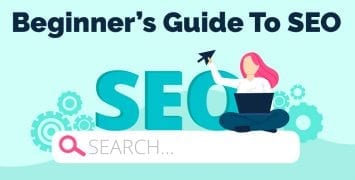Everyone wants more website traffic, but most don’t put in the effort, and others just don’t know the effective ways to do it. For those of you who follow Webitect, you know I’ve created quite a few posts on website traffic and may have read a few. Still, I thought I’d write another one– this time compiling all the great website traffic gaining tips from before. Hopefully, this post can be a great reminder for returning readers or a wealth of knowledge for first-time visitors.
These 30 tips are divided into three main website traffic categories:
- Search Engine Optimization and other initial technicalities
- Offering good material that can go viral
- Finding loyal readers and creating a community
SEO & Other Technicalities
1. Exponential Growth
“Exponential growth with website traffic is the idea that, over time, your visitor count will grow, and as time goes on, it will grow faster.”
This an incredibly powerful way to gain a steady income of website traffic, given patience and the correct planning.
2. Use Proper SEO
SEO stands for Search Engine Optimization. It calls for optimizing your site in such a way that you will rank higher in all search engines by letting the search engine’s algorithms read your website more effectively.
By ranking higher, you can see increased visitors from search engines, rank higher on other ranking sites like Alexa, and potentially sell more advertising space.
SEO is a learned practice, and with proper research, it can do wonders. Below are some basic SEO tips.
- Find keywords that are relevant to your site and it contents, and use them throughout the meta tags, page title, post titles, navigation, and in the actual content.
- Try to obtain links to your site from higher ranking websites.
- Have patience– older websites rank better. Keep a domain name for more than a year.
- Plan your site architecture effectively. Visitors should be able to navigate it easily, and so should search engines.
- Always use the alt attribute for images and similar tags for other elements. Search engines can’t read images, but they can read alt attributes.
Other SEO Tips:
- http://www.searchenginejournal.com/55-quick-seo-tips-even-your-mother-would-love/6760
- http://searchengineland.com/21-essential-seo-tips-techniques-11580
- http://www.ezau.com/latest/articles/0147.shtml
3. Have a Blogging Platform
Blogging platforms are a search engine’s best friend. With an organized programming structure and easy to find updated content, new information is served to the search engine to crawl each time you make a post.
WordPress offers many SEO friendly plugins in addition to the benefits provided by the platform itself.
4. Analyze Traffic Correctly
Finding your main sources of website traffic can guide you in the right direction for gaining more. Find which sites you gain the most from, and what you did to get those visitors. You may also see trends in popularity for a type of post you wrote.
5. Be Compatible
This elementary, but the wider your audience can be, the more audience there will be. Make sure your site is validated. This will allow visitors with outdated browsers, old operating systems, and users who use software that isn’t mainstream see your site correctly.
Always keep usability in mind for the target audience. Consider simplistic or complex design, fluid or fixed layouts, navigation organization, and writing style based on who you’re creating the website for.
6. Brand your Website
Early on any website should create an official logo and slogan to be used. As they are used more throughout the lifetime of your website, you’ll gain recognition and professionalism.
With a slogan, it can be made to be keyword friendly and catchy. Reusing this can save time while still getting effective results for an about page, guest blog post, forums, and other advertising venues.
Problogger is featuring a series called 31 Days to a Better Blog, and day one of this series is entitled “Write an Elevator Pitch for Your Blog”. Taking the time to create one of these can be extremely beneficial to branding your website.
Offer Good Material
7. Write a Tutorial
Anything that teaches your readers something is good material. Create an excellent, well thought out, and detailed tutorial about something you know about. Your readers will thank you for it. Tutorials are also very viral marketing solutions in social networking sites.
After creating a quality tutorial, submit to tutorial sites. Pixel2Life is one of the greatest referrers to Webitect, and I’ve only submitted three tutorials to the site.
8. Submit your Content
After you spend your time and effort making great content, start submitting it to content sites. Spreading your content to bigger sites will give the content a wider audience, and some of that audience will want to head back to your site for more.
There are plenty of websites that allow you to submit your content for free, just do a Google search.
9. Write Effective Content
Effective website content is keyword friendly, easy to scan, and organized.
Keyword friendly content can help out a lot in terms of SEO, by helping search engines find and rank you appropriately. Use a top list of relevant keywords throughout your content each time you write, but so it still sounds natural.
Creating easy to scan and organized content will help the reader get the most of the article. You can host a ton of information in an article, but if it’s not written properly for the web, people won’t read it. Learn how to write web content your visitor will read, and remember the two top rules: easy to scan and organized.
10. Make List Posts
List posts go viral. If you’ve ever followed a popular blog, you can see that many of the posts are something like “30 ways to…”, or “19 High Resolution…”. For better example, a list post is just like this post, “20 Effective Ways to Increase Website Traffic.”
There are plenty of reasons why list posts are so popular:
- With a number, the reader is attracted to the title because they feel they’re going to get more useful information out of it.
- List posts are automatically more organized and easy to scan.
- List posts force the author to create well-written and useful content by making them stick to an initial amount of content. It also helps the author to evenly expand upon all the points, or features, of the list items.
11. Offer Free Content
Offer a free content that is not in the form of a post or article. A little something extra will tell your readers that you spent more time on this piece of content and that it is of higher quality.
Things of graphic nature are most common: WordPress themes, icons, CSS templates, etc. It can also be something informative–something extra your readers can find–such as an e-book.
When people use your content, depending on the type of content, two things could happen: 1) they’ll link back to you, or you’ll already have a link on the content they use (such as in a free WordPress Theme), or 2) they’ll be grateful for the content and want to come back for more. Either way, you get repeat and possibly new visitors.
12. Use Social Networking Sites and Twitter
Social networking sites are a great way to promote your own content. You can add your link to the entire site, or link to original pieces of content. Better yet, you can add comments for content descriptions to peak the potential reader’s interest.
Sites like Twitter or Facebook can be used on a more personal level to create a community on your site. Not only can you post new links, but ask questions and get answers concerning your site, interact with your followers with their updates, and create a better bond with your followers overall.
13. Write on Other Blogs
Writing on another person’s blog is a great way to bring targeted traffic to your site. You create a link between you and the blogger, and anyone who reads your comment may click on your link out of curiosity. Write on blogs that seem to share the kind of traffic you want. Blogs in your niche are ideal.
Write relevant and useful blog comments. It’s even better when you can add your own opinion or experience to a post, rather than “Good post, keep up the good work.” Others read through blog comments more than you may think, and it can be helpful in terms of website traffic for your site to be more productive in the discussion.
Find Loyal Readers
14. RSS & Email Feed
Let your readers subscribe through RSS and email. Having multiple gateways for readers to subscribe only means they’ll be more likely to subscribe.
When one of your visitors subscribes even after one of the first times they’ve visited, your link and updated posts will always be on their reader (or in their email). They’ll see titles that can peak their interest, and you’ll have a much higher return rate for that visitor. Without any subscription type whatsoever, many visitors may come by, really enjoy your site, but easily forget about it tomorrow.
15. Newsletter
A reader may not want an email message every time you write a new post, but they may want one when you have some updates and something bigger to say. Create a newsletter and send it out weekly, bi-weekly, or monthly.
You can include updates for your site, any new articles the subscriber may be interested in, and some behind-the-scenes tips or articles for newsletter subscribers only. This will make your reader feel like a ‘special’ contributor to your site, creating more loyalty.
16. Create a Sense of Community
In a few other sections, I’ve talked about how to add a sense of community and why it can be beneficial. Creating community creates loyalty, and loyal readers are two things: repeat visitors and referrers to your site.
Step it up a notch and really focus on how to add community. Analyze and research new outlets that could help you. You could start a contest, focus on gaining comments, create a forum, or allow memberships to your site with special privileges.
17. Update Regularly
Even the most loyal reader can lose interest. I used to be a loyal reader to one of my favorite blogs, but the author only updates about once a month now– and sometimes his updating is a bit haywire. He’s blogged a few times a week and then not for another month. I’ve already unsubscribed. He has some great content and does everything else right, so I’ll check back every once in awhile. However, my interest, and I believe the interest of many of his other readers, has dropped significantly because of his lack of a blogging schedule.
It is important to maintain a somewhat regular blogging schedule. Even if you don’t have time to create an intricate post, you can post something interesting you’ve found, a small trick you’ve come across, or even a small informative post that takes half the time to write. While it should still be of top quality, it doesn’t have to be long.
I try to update every other day, and with my busy schedule, it doesn’t always happen. I’m just starting to get into somewhat of a routine that matches this goal, but it takes some planning. As I’ve done this my blog has grown. Create a schedule for yourself.
18. Follow Your Readers
Follow your own followers on Twitter, social networking sites, and on their blog. Get to know them and whey they come to your blog.
Following your readers can have a lot of benefits. You’ll create a better sense of community between you and the reader, gaining loyalty. You’ll also be able to better analyze the type of audience you’re attracting, and why.
Following your readers can give you ideas for new content as well. You can really get a sense of what the reader needs out of your blog, by just paying a bit of attention to them.
19. Start a Series
Start a series, even if it’s for only two to three posts. It can be an article series, tutorial series, or a series of interesting things you find. Once the first few are out, it will make your readers want to come back for updates. It will also make a lot of first timers that you catch on the first day of the series want to come back.
It may be helpful to release a series in a pattern, such as every Monday, or every day for a month. This can attract your readers to visit your website on days they know the new content will be out.
20. Encourage Promotion
Provide links that allow your readers to promote each post, such as a “Digg This” button. I have social media icons at the bottom of each post, and it helps out tremendously. Use larger icons that represent what promotion tool you want the user to use the most. Digg, StumbleUpon and my RSS feed may be the most beneficial.
Provide links to these bookmarking tools not only on each post but somewhere on the main site as well. This will help visitors who enjoy your site, share it in its entirety. Also, include a link to your subscribing options and Twitter so they can follow you and your content easily.




